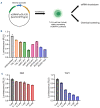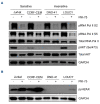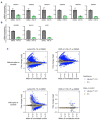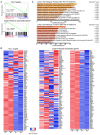Targeting dual oncogenic machineries driven by TAL1 and PI3K-AKT pathways in T-cell acute lymphoblastic leukemia
- PMID: 36073513
- PMCID: PMC9890034
- DOI: 10.3324/haematol.2022.280761
Targeting dual oncogenic machineries driven by TAL1 and PI3K-AKT pathways in T-cell acute lymphoblastic leukemia
Abstract
T-cell acute lymphoblastic leukemia (T-ALL) is a malignancy of thymic T-cell precursors. Overexpression of oncogenic transcription factor TAL1 is observed in 40-60% of human T-ALL cases, frequently together with activation of the NOTCH1 and PI3K-AKT pathways. In this study, we performed chemical screening to identify small molecules that can inhibit the enhancer activity driven by TAL1 using the GIMAP enhancer reporter system. Among approximately 3,000 compounds, PIK- 75, a known inhibitor of PI3K and CDK, was found to strongly inhibit the enhancer activity. Mechanistic analysis demonstrated that PIK-75 blocks transcriptional activity, which primarily affects TAL1 target genes as well as AKT activity. TAL1-positive, AKT-activated T-ALL cells were very sensitive to PIK-75, as evidenced by growth inhibition and apoptosis induction, while T-ALL cells that exhibited activation of the JAK-STAT pathway were insensitive to this drug. Together, our study demonstrates a strategy targeting two types of core machineries mediated by oncogenic transcription factors and signaling pathways in T-ALL.
Figures








Similar articles
-
TAL1 cooperates with PI3K/AKT pathway activation in T-cell acute lymphoblastic leukemia.Haematologica. 2022 Oct 1;107(10):2304-2317. doi: 10.3324/haematol.2021.279718. Haematologica. 2022. PMID: 35354248 Free PMC article.
-
TAL1 hijacks MYCN enhancer that induces MYCN expression and dependence on mevalonate pathway in T-cell acute lymphoblastic leukemia.Leukemia. 2023 Oct;37(10):1969-1981. doi: 10.1038/s41375-023-01993-y. Epub 2023 Aug 17. Leukemia. 2023. PMID: 37591943
-
CASZ1 upregulates PI3K-AKT-mTOR signaling and promotes T-cell acute lymphoblastic leukemia.Haematologica. 2024 Jun 1;109(6):1713-1725. doi: 10.3324/haematol.2023.282854. Haematologica. 2024. PMID: 38058200 Free PMC article.
-
Oncogenic transcriptional program driven by TAL1 in T-cell acute lymphoblastic leukemia.Int J Hematol. 2019 Jan;109(1):5-17. doi: 10.1007/s12185-018-2518-z. Epub 2018 Aug 25. Int J Hematol. 2019. PMID: 30145780 Review.
-
Targeting signaling pathways in T-cell acute lymphoblastic leukemia initiating cells.Adv Biol Regul. 2014 Sep;56:6-21. doi: 10.1016/j.jbior.2014.04.004. Epub 2014 Apr 30. Adv Biol Regul. 2014. PMID: 24819383 Review.
Cited by
-
Repression of LSD1/KDM1A activity improves the response of liver cancer cells to the lenvatinib.Discov Oncol. 2024 Mar 28;15(1):89. doi: 10.1007/s12672-024-00947-9. Discov Oncol. 2024. PMID: 38538885 Free PMC article.
-
Enhancers in T Cell development and malignant lesions.Cell Death Discov. 2024 Sep 17;10(1):406. doi: 10.1038/s41420-024-02160-7. Cell Death Discov. 2024. PMID: 39284807 Free PMC article. Review.
-
EGFR and PI3K Signalling Pathways as Promising Targets on Circulating Tumour Cells from Patients with Metastatic Gastric Adenocarcinoma.Int J Mol Sci. 2024 May 20;25(10):5565. doi: 10.3390/ijms25105565. Int J Mol Sci. 2024. PMID: 38791602 Free PMC article.
-
Encapsulation and Delivery of the Kinase Inhibitor PIK-75 by Organic Core High-Density Lipoprotein-Like Nanoparticles Targeting Scavenger Receptor Class B Type 1.ACS Appl Mater Interfaces. 2025 Jan 8;17(1):363-373. doi: 10.1021/acsami.4c15472. Epub 2024 Dec 17. ACS Appl Mater Interfaces. 2025. PMID: 39688216
References
-
- Look AT. Oncogenic transcription factors in the human acute leukemias. Science. 1997;278(5340):1059-1064. - PubMed
-
- Armstrong SA, Look AT. Molecular genetics of acute lymphoblastic leukemia. J Clin Oncol. 2005;23(26):6306-6315. - PubMed
-
- Aifantis I, Raetz E, Buonamici S. Molecular pathogenesis of T-cell leukaemia and lymphoma. Nat Rev Immunol. 2008;8(5):380-390. - PubMed
-
- Van Vlierberghe P, Pieters R, Beverloo HB, Meijerink JP. Molecular-genetic insights in paediatric T-cell acute lymphoblastic leukaemia. Br J Haematol. 2008;143(2):153-168. - PubMed
-
- Belver L, Ferrando A. The genetics and mechanisms of T cell acute lymphoblastic leukaemia. Nat Rev Cancer. 2016;16(8):494-507. - PubMed
Publication types
MeSH terms
Substances
LinkOut - more resources
Full Text Sources
Molecular Biology Databases

